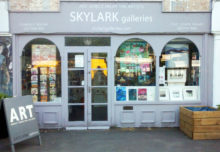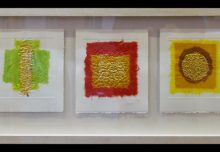QUIT YOUR DAY JOB, BECOME AN ARTIST.
If you like making art you might want to progress from hobby artist to professional artist. But you will soon find that you cannot get a job as an artist. Professional artists are self-employed. They have to be. There are no paid jobs as ‘artists’.
Artists are solitary businesses. And as a consequence they need to do all the business tasks themselves. They will need to be good at everything. And that explains why most artists don’t get rich.
Making visual art is a solitary occupation. Artists very rarely create in groups or even pairs. Gilbert and George are an exception. Very successful artists like Damien Hurst will have assistants in his employ doing some of his work for him. That is very unusual indeed.
The fact remains that all the rest of us artists work alone. And if we are ambitious and want to be more than a hobby artist we will have to be a small, self-sufficient, one-man or one-woman, art production venture. We will have to get good at marketing, selling, social media, accounts and record keeping, business development, and continuous research into changing markets, and lots more. It is a 24/7 adventure.
This is why hopeful artists might expect to find that there are other business people who offer crucial services such as marketing and selling. But this route usually calls for hefty up-front investment unless the artist has already established a reputation or has a record of success. When, or if, an artist is taken up by a large publishing house or gallery, they soon come to realize that they will only be getting a small share of any sales income from their work. Artists who look for fairy godmothers are usually disappointed.
So artists are generally doomed to business failure. That is unless they join together with other artists to share some of the art business tasks.
So why don’t artists work in groups?
Maybe it is because being a full-time artist is so unusual that there is not an established group way of doing things. Perhaps it is actually quite difficult to work as a group in the art business.
Maybe it is because solo artist status has become socially expected. The mind-set says that as an artist you will probably starve in your studio, basking in self-satisfying solitude. Sacrifice all for your art! If you achieve any success it is because you have compromised. Artists can actually feel very guilty when they sell things.
Another important reason why artists work alone is probably in the nature of the creative process. It is difficult to put into words what you are putting into art creation. It is hard to work with other artists who are also used to working alone because we are all exploring unknown territory. My unknown is different to yours.
So is it impossible for artists to work together to enable business success?
This phrase has been aired before……
“ORGANIZING ARTISTS IS LIKE HERDING CATS”
Herding cats? Maybe not.
Skylark Galleries in London is one example of an artist’s collective where artists pool expertise and experience. And where artists as a group can jointly afford to pay for and manage their own retail outlets. In Skylark Galleries case there are two bricks and mortar spaces, plus an online retail shop. Skylark Galleries are situated in a superb location on the South Bank in London. They are able to open to the public for 364 days a year by sharing the task of manning the galleries.
Another example that has become widespread has been artist run ‘open-house’ and ‘open-studio’ exhibitions. This is where a number of artists get together to organize the same exhibition days and joint advertising to make their events a much more attractive thing for prospective visitors. These are usually just for a few days each year. But they have been successful in many instances.
Both of these examples could be models for the future.
*********************************************************





